Health Care > QUESTIONS & ANSWERS > SCI 228 Week 1 Variety answer to Quiz latest solution (All)
SCI 228 Week 1 Variety answer to Quiz latest solution
Document Content and Description Below
SCI 228 Week 1 Variety answer to Quiz latest solution Grading Summary Grade Details - All Questions Question 1. Question : (TCO 1) Which statement is FALSE concerning the field of nutrition? ... Question 2. Question : (TCO 1) ________ refers to eating the right proportion of foods. Question 3. Question : (TCO 1) What is at the base of the Healthy Eating Pyramid? Question 4. Question : (TCO 1) Which of the following is exempt from standard food labeling regulations? Question 5. Question : (TCO 3) Responding to the presence of protein and fat in our meal, cholecystokinin (CCK) signals the gallbladder to release a substance called: Question 6. Question : (TCO 3) The acidity of the stomach allows for all of the following EXCEPT: Question 7. Question : (TCO 3) Why do fungi rarely cause food infection? Question 8. Question : (TCO 3) Which of the following is responsible for food spoilage? Question 9. Question : (TCO 3) In the United States, the most common food-borne illnesses result from which of the following bacteria? Question 10. Question : (TCO 3) Which government agency regulates the labeling, sale, distribution, use, and disposal of all pesticides in the United States? * Times are displayed in (GMT-07:00) Mountain Time (US & Canada) Name: Test #1 Status : Needs Grading Score: 13 out of 20 points Time Elapsed: 0 hours, 42 minutes, and 36 seconds out of 0 hours and 40 minutes allowed. Instructions: You will have 40 minutes to take the test. There are 40 questions. Each question is worth 1/2 point for a total of 20 points. You will need a calculator for this test. Once you start, you will not be able to take it again if you stop. So make sure you have a time when you will be uninterrupted. Please print out your score page incase of any problems. Always check your score to see if it has registered in Gradebook. If you experience any problems, contact me immediately! Question 1 Multiple Choice 0.5 of 0.5 points The smallest units of matter that normally cannot be broken down are: Question 2 Multiple Choice 0 of 0.5 points Which of the following is NOT a function of dietary protein? Question 3 Multiple Choice 0.5 of 0.5 points Hunger is best described as: Question 4 Multiple Choice 0.5 of 0.5 points The building blocks of proteins are called: Question 5 Multiple Choice 0 of 0.5 points The _______is most responsible for prompting individuals to seek food. Question 6 Multiple Choice 0.5 of 0.5 points Which of the following is required on all food labels? Question 7 Multiple Choice 0.5 of 0.5 points In which organ does most water absorption occur? Question 8 Multiple Choice 0.5 of 0.5 points Proteins that act to speed up body processes, but are not changed in the process, are called: Question 9 Multiple Choice 0 of 0.5 points There are many types of diet plans available today. The best diet plan overall is the one that: Question 10 Multiple Choice 0 of 0.5 points Bob eats his breakfast and his GI tract will now begin the process of digesting and absorbing the nutrients from his meal. What is the order in which each of the organs of the GI tract will work to achieve this process? Question 11 Multiple Choice 0.5 of 0.5 points Vitamin C and B are termed: Question 12 Multiple Choice 0.5 of 0.5 points The type of study that observes a large population to determine factors that may influence nutritional habits and disease trends is called a(n): Question 13 Multiple Choice 0 of 0.5 points In which group are cheeses listed in the Exchange System? Question 14 Multiple Choice 0 of 0.5 points Jack is a college athlete who requires 2800 kilocalories a day to support his total energy needs. Even though Jack likes many different foods and makes it a point to try new things, he only consumes approximately 1600 kilocalories a day. Which one of the characteristics of a healthy diet is Jack missing? Question 15 Multiple Choice 0.5 of 0.5 points ________ refers to eating the right amount of foods. Question 16 Multiple Choice 0.5 of 0.5 points Which of the following nutrients is organic? Question 17 Multiple Choice 0.5 of 0.5 points Which of the following is an example of carbohydrate-rich foods? Question 18 Multiple Choice 0 of 0.5 points Assuming each has the same number of calories, which has the greatest nutrient density? Question 19 Multiple Choice 0 of 0.5 points What is the name of the sphincter that separates the stomach from the small intestines? Question 20 Multiple Choice 0 of 0.5 points Diets high in sugar are directly associated with: Question 21 Multiple Choice 0 of 0.5 points The 5-A-Day The Color Way Program was developed by the: Question 22 Multiple Choice 0.5 of 0.5 points What is chyme? Question 23 Multiple Choice 0.5 of 0.5 points The Dietary Guidelines for Americans recommends consuming less than _______mg of sodium each day. Question 24 Multiple Choice 0.5 of 0.5 points _________ are examples of inorganic nutrients. Question 25 Multiple Choice 0.5 of 0.5 points Cell membranes are PRIMARILY composed of: Question 26 Multiple Choice 0.5 of 0.5 points The information provided on the food label that identifies intake of nutrients based on 2000 calories a day is called the: Question 27 Multiple Choice 0.5 of 0.5 points The Dietary Guidelines for Americans recommends a minimum of: Question 28 Multiple Choice 0 of 0.5 points Jack's lunch contains 121 grams of carbohydrate, 40 grams of protein, and 25 grams of fat. What percent of kilocalories in this meal come from fat? Question 29 Multiple Choice 0.5 of 0.5 points Which statement best describes nutrient density? Question 30 Multiple Choice 0.5 of 0.5 points The human body is organized into the following structural levels: Question 31 Multiple Choice 0.5 of 0.5 points What element makes protein different from carbohydrate and fat? Question 32 Multiple Choice 0.5 of 0.5 points Vitamins are classified into two groups; _____ and _____. Question 33 Multiple Choice 0.5 of 0.5 points Which of the following describes the vitamins A, D, E, and K? Question 34 Multiple Choice 0 of 0.5 points The "powerhouse" of the cell that provides the most ATP is the: Question 35 Multiple Choice 0 of 0.5 points Bicarbonate is released into the duodenum during the process of digestion. Why? Question 36 Multiple Choice 0.5 of 0.5 points _______serve as an important source of energy for muscles during times of rest and low-intensity exercise. Question 37 Multiple Choice 0.5 of 0.5 points Which of the following is NOT an essential nutrient? Question 38 Multiple Choice 0.5 of 0.5 points Which two pancreatic hormones are responsible for maintaining blood glucose levels? Question 39 Multiple Choice 0.5 of 0.5 points The government agency that regulates the food labels on fresh meat and poultry in the United States is the: Question 40 Multiple Choice 0 of 0.5 points Healthier fat sources include _______ and vegetable oils. Nutrition for Life, 3e (Thompson) Chapter 2 The Human Body: Are We Really What We Eat? Multiple-Choice Questions 1) Which of the following are grouped together to perform an integrated function? A) molecules B) tissues C) systems D) organelles 2) Which of the following is MOST responsible for prompting individuals to seek food? A) stomach B) small intestine C) hypothalamus D) mouth 3) Which physiological trigger(s) will result in the sensation of hunger? A) low glucose levels B) high glucose levels C) release of the chemical messengers leptin and serotonin D) eating a meal with a high satiety value 4) Hunger is best described as A) a physiological desire to find food and eat. B) a psychological desire to find food and eat. C) eating that is often driven by environmental cues. D) eating that is often driven by emotional cues. 5) Which of the following is NOT a regulator of satiety in the body? A) GI tract B) hypothalamus C) hormones D) kidneys 6) Which of the following snacks will have the highest satiety value, assuming the calories and relative size are similar? A) slice of whole-grain bread B) piece of cheese C) glass of whole milk D) glass of skim milk Aswer: B Page Ref: 39 7) The smallest units of matter that cannot be broken down by natural means are A) atoms. B) molecules. C) cells. D) lipids. 8) The human body is organized into the following structural levels (smallest to largest) A) molecules: atoms: organs: systems: tissues: cells. B) atoms: molecules: cells: tissues: organs: systems. C) organs: tissues: molecules: systems: atoms: organs. D) atoms: cells: systems: tissues: molecules: organs. 9) Cell membranes are A) very rigid and resistant to all noncellular molecules. B) semipermeable. C) the organelles responsible for ATP production. D) chemical messengers that are secreted into the bloodstream by a gland. 10) In which organelle is the cell's DNA located? A) nucleus B) mitochondria C) cell membrane D) cytoplasm 11) The "powerhouses" of the cell that produce energy from food molecules are the A) mitochondria. B) ribosomes. C) nuclei. D) cytoplasm. 12) What is the term that describes the process by which the foods we eat are broken down into smaller components by either mechanical or chemical means? A) digestion B) absorption C) elimination D) peristalsis 13) Which of the following is NOT a role that the liver plays in digestion and absorption of nutrients? A) Filters the blood, removing potential toxins such as alcohol and drugs. B) Secretes insulin and glucagon to assist in the regulation of blood glucose concentrations. C) Receives the products of digestion from the small intestine and releases nutrients depending on body needs. D) Synthesizes bile to assist in the digestion and absorption of fat. 14) Most digestion and absorption occurs in the A) stomach. B) esophagus. C) small intestine. D) mouth. 15) Juanita eats her breakfast, and her GI tract then begins the process of digesting and absorbing the nutrients from this meal. What is the order in which each of the organs of the GI tract will work to achieve this process? A) mouth: esophagus: small intestine: stomach: large intestine B) mouth: esophagus: stomach: small intestine: large intestine C) mouth: stomach: esophagus: small intestine: large intestine D) mouth: stomach: esophagus: large intestine: small intestine 16) The mechanical and chemical digestion of food is initiated in the A) mouth. B) small intestine. C) stomach. D) esophagus. 17) Salivary amylase is a(n) A) hormone. B) antibody. C) bicarbonate. D) enzyme. 18) Which best explains why carbohydrate digestion ceases when food reaches the stomach? A) Carbohydrate is completely digested in the mouth. B) Salivary amylase cannot function in the acid environment of the stomach. C) Carbohydrate is completely absorbed in the esophagus. D) Intestinal bacteria are needed for carbohydrate digestion. 19) Which of the following is NOT a component of the gastric juices? A) hydrochloric acid B) pepsin C) insulin D) gastric lipase 20) What is chyme? A) ulcerations of the esophageal lining B) healthy bacteria of the small intestine C) mixture of partially digested food, water, and gastric juices D) substance that allows for the emulsification of dietary lipid 21) A primary function of the mucus in the stomach is to A) neutralize stomach acid. B) activate pepsinogen to form pepsin. C) protect stomach cells from digestion. D) emulsify fats. 22) Which of the macronutrients is NOT broken down chemically in the stomach? A) protein B) carbohydrate C) fat D) vitamin C 23) Proteins that induce chemical changes to speed up body processes are called A) hormones. B) peptides. C) enzymes. D) chymes. 24) The brush border is located in the A) esophagus. B) stomach. C) small intestine. D) large intestine. 25) What is the name of the sphincter that separates the esophagus and the stomach? A) pyloric B) gastroesophageal C) ileocecal D) rectal 26) The last section of the small intestine that connects to the ileocecal valve is called the A) bile duct. B) duodenum. C) jejunum. D) ileum. 27) Responding to the presence of fat in our meal, the gallbladder releases a substance called A) lipase. B) pepsin. C) chyme. D) bile. 28) What roles do the hormones insulin and glucagon play in signaling hunger? A) They detect changes in pressure in the stomach. B) They stimulate release of digestive juices. C) The respond to changing glucose levels and signal the hypothalamus. D) They initiate movements in the GI tract known as "hunger pangs." 29) The fingerlike projections of the small intestine that increase surface area and allow for the absorption of nutrients are called A) villi. B) lacteals. C) sphincters. D) diverticuli. 30) Which circulatory system carries most of the fats and fat-soluble nutrients? A) vascular B) mesenteric C) lymphatic D) enterohepatic 31) Which large vessel transports absorbed nutrients to the liver? A) portal vein B) pulmonary vein C) aorta D) subclavian vein 32) In which organ does the majority of water absorption occur? A) mouth B) stomach C) small intestine D) large intestine 33) Collectively, the nerves of the gastrointestinal tract are referred to as A) peptic nerves. B) hepatic nerves. C) enteric nerves. D) gastric nerves. 34) If a person has GERD, which of the following is probably malfunctioning? A) gallbladder B) pancreas C) epiglottis D) gastroesophageal sphincter 35) What is the primary cause of peptic ulcers? A) stress B) H. pylori bacteria C) prolonged use of aspirin D) eating too many spicy foods 36) Which of the following would be an appropriate treatment approach for someone who has GERD? A) surgical removal of the gallbladder B) omission of all lactose foods C) antibiotic therapy D) lose weight and quit smoking 37) Which of the following statements best describes irritable bowel syndrome (IBS)? A) an erosion of the gastrointestinal tract caused by the overproduction of hydrochloric acid B) an immune response resulting from the ingestion of an allergen C) a hypersensitivity to wheat resulting in diarrhea and bloating D) a bowel disorder that interferes with the colon; no definite cause is known 38) Mary experiences anaphylactic shock after eating a peanut butter sandwich. What is the most appropriate treatment for Mary? A) IV glucose B) Tylenol or another pain medication C) antibiotics D) epinephrine 39) The liquid within an animal cell is known as A) gastric juice. B) glucagon. C) cytoplasm. D) mitochondria. 40) The psychological desire that encourages us to seek out a particular food is A) hunger. B) appetite. C) satiety. D) anorexia. 41) The the region of the forebrain where physiological signals are translated into thirst and hunger messages is the A) pituitary gland. B) adrenal gland. C) thalamus. D) hypothalamus. 42) Secreted from many glands of the body, hormones acts as A) "powerhouses" of cells. B) chemical messengers that trigger a physiological response. C) absorptive features that increase the surface area of the small intestine. D) fat emulsifiers. 43) In contrast to hunger, appetite is triggered by A) signals from nerve cells in the stomach lining. B) insulin and glucagon. C) satiety. D) the sensory appeal of foods and their learned social and cultural associations. 44) The state in which a person has a physiologic need for food but no appetite is known as A) anorexia. B) peristalsis. C) satiety. D) hunger. 45) A functional grouping of similar cells is known as a(n) A) atom. B) molecule. C) tissue. D) organ. 46) Tight rings of muscles that control the movement of food through the organs of the gastrointestinal tract are known as A) villi. B) microvilli. C) mitochondria. D) sphincters. 47) Approximately how long is the human GI tract? A) 30 inches B) 30 feet C) 50 inches D) 50 feet 48) Elimination is the bodily process in which A) undigested portions of food and waste are removed from the body. B) the products of digestion are taken through the wall of the intestine. C) food is chemically and physically broken down into component molecules. D) probiotics are produced. 49) Carbohydrate digestion begins in the A) mouth. B) stomach. C) small intestine. D) large intestine. 50) Protein digestion begins in the A) mouth. B) stomach. C) small intestine. D) large intestine. 51) Which structure keeps food from entering the trachea during swallowing? A) upper esophageal sphincter B) lower esophageal sphincter C) soft palate D) epiglottis 52) The wavelike contractions that move food along the GI tract are known as A) proteases. B) pepsin. C) peristalsis. D) pituitary glands. True/False Questions 1) Atoms are the smallest units of matter. 2) The cell's nucleus is the organelle responsible for producing energy from food molecules. 3) Hunger is the physical sensation that drives humans to eat. 4) The primary organ producing the sensation of hunger is the stomach. 5) Foods containing carbohydrate have the highest satiety value. 6) Overall, very little digestion occurs in the human mouth. 7) Typically, ingested food remains in the stomach for 2 hours prior to traveling to the small intestine. 8) The pancreas is the largest digestive organ. 9) The small intestine is the longest portion of the human GI tract. 10) The majority of nutrient absorption takes place in the stomach. 11) Since they do not require further digestion, dietary vitamins and minerals are small enough to be absorbed by the gastrointestinal tract. 12) The presence of any bacteria in the large intestine indicates a potentially serious systemic allergic reaction that can be fatal if left untreated. 13) The most common symptom of GERD is chronic diarrhea. 14) Irritable bowel syndrome is more common among women than men. 15) The sigmoid colon is the first segment of the large intestine. 16) Food allergies cause an immune response by the body. 17) Most instances of constipation are caused by intestinal bacteria. 18) Diarrhea and dehydration are the most serious potential reactions when consuming an allergenic food product. 19) Untreated diarrhea can be fatal in young children. 20) Currently, the only treatment for celiac disease is a diet free of wheat, barley, and rye. 21) Adults cannot learn to enjoy a food unless it was introduced to them in childhood. 22) Produced by the liver, bile is stored in the gallbladder and emulsifies fats in the small intestine. 23) The brush border is a term that describes the microvilli of the large intestine's lining. 24) The gallbladder secretes bicarbonate into the small intestine to neutralize the acidity of chyme. 25) Celiac disease can only be diagnosed with a blood test. Essay Questions 1) Starting at the mouth and ending at the rectum, describe the process of human digestion and absorption. 2) Describe the symptoms and treatment of irritable bowel syndrome (IBS). 3) Describe the lining of the small intestine. How does its unique structure contribute to the process of nutrient absorption? 4) What is the difference between a food intolerance and a food allergy? Questions from Chapter Boxes 1) Bile reacts with fats in a similar way as soap does. 2) Probiotics have been shown to be effective in treating A) traveler's diarrhea. B) food allergies. C) gastroesophageal reflux disease (GERD). D) diabetes mellitus. 3) Traveler's diarrhea is caused by A) food allergies. B) stress. C) antibiotic overuse. D) viral or bacterial infections. 4) One appetizing and safe alternative to barley for people with celiac disease is A) wheat. B) gluten. C) Job's tears. D) rye. 5) Because the activity of probiotics in the GI tract is short-lived, they need to be consumed on a daily basis to be effective. 6) Which of the following food sources is a rich source of probiotics? A) whole-wheat bread B) yogurt C) orange juice D) calcium supplements 7) The emerging field of nutrigenomics studies how nutrition and environment can affect gene function. 8) What are probiotics and how are they involved in keeping us healthy? 9) List the eight major allergenic foods. Explain how and why the U.S. Food and Drug Administration (FDA) regulates these ingredients in packaged foods. Chapter 14 1. All preservatives must be listed on the food label. 2. One limitation of using aseptic packaging is that it is an environmentally unfriendly process. 3. The majority of food allergies cause an immediate reaction. 4. Nitrates have been shown to cause cancer in humans. 5. Thoroughly cooking beef, pork, or fish will destroy helminth larvae and prevent infection. 6. In the United States, the most common food-borne illnesses result from which of the following bacteria? 7. An estimated ________ of all chicken eggs in the U.S. are contaminated with Salmonella. 8. Pesticides are: 9. The food-borne illness caused by Campylobacter jejuni is associated with consuming: 10. Hepatitis A is a food-borne virus that can result in ________ damage. 11. Foods of animal origin are the most common sources of food-borne illnesses. 12. Refrigerating or freezing foods will kill any bacteria present in the food. 13. The majority of food infections are caused by bacteria. 14. Yellow dye #6, corn syrup, and calcium added to orange juice are all examples of: 15. The easiest and most effective way to prevent food-borne illnesses is to: 16. Which of the following is TRUE concerning the safe storage of leftovers? 17. All additives are synthetic. 18. Children never outgrow food allergies. 19. Consuming processed foods as opposed to whole foods decreases the risk of contracting a food-borne illness. 20. Mad cow disease has never been reported in the United States. 21. ________ is added to table salt in the United States in order to reduce the risk of developing a goiter. 22. Which agency monitors all confirmed cases of food-borne illness? 23. Which of the following preservatives is(are) commonly used to prevent rancidity in oils and fats? 24. Which of the following is an example of food intoxication? 25. There are no labeling requirements for products containing recombinant bovine growth hormone (rBGH). 26. Which of the following is NOT a recommended method for preventing cross-contamination? 27. Which of the following is NOT an advantage of using biopesticides? 28. Why do fungi rarely cause food infection? 29. Products that are "100% organic" or "organic" must display the USDA seal. 30. It is unsafe to use food past its "use by" date. 31. To decrease the exposure to food allergens it is wise to eat less processed and more organically grown foods. 32. Which of the following temperature ranges provides optimal growth for the majority of food-borne microbes? 33. Why is rBGH given to many U.S. dairy cows? 34. Which of the following is responsible for food spoilage? 35. All of the following are protective responses to encountering food-borne microbes EXCEPT: 36. Which government agency regulates the labeling, sale, distribution, use, and disposal of all pesticides in the United States? 37. Clostridium botulinum thrives in an acidic environment. 38. The toxins produced by microbes are destroyed by heat. 39. WRONG ANSWER Which of the following are the most common form of pesticides? 40. Bovine spongiform encephalopathy is a food-borne illness also known as: 41. Which of the followingBESTdescribes the Delaney Clause? 42. Organic farmers cannot use pesticides. 43. Which of the following is an example of a persistent organic pollutant? 44. Which of the following food preservation methods limits spoilage by drawing water out of foods, making them inhospitable to bacterial growth? 45. Which of the following additives gives ham, hot dogs, and bologna their pink color? 46. Which government agency regulates organic farming standards in the United States? 47. Irradiation is a permitted preservation technique used by organic farmers. 48. Which of the following is FALSE regarding the prion that causes mad cow disease? 49. Food infections result from consuming foods in which microbes have secreted poisonous toxins. 50. A cyclic food allergy is one that: 51. The primary method used to preserve seafood is: 52. Each year it is estimated that over ________ percent of the U.S. population has symptoms of food-borne illness without knowing or reporting it. 53. It is unsafe to thaw frozen foods on the kitchen counter (at room temperature). 54. Which human organ system is most affected by toxic levels of mercury? 55. In which of the following environments does Clostridium botulinum flourish? 56. Ninety (90) percent of all food allergies are due to the ________ found in foods. 57. Some researchers consider food allergies a form of food-borne illness. 58. The safety of raw seafood cannot be guaranteed; it must be cooked. 59. The two types of fungi are: 60. The proper steps developed for canning foods ensures that all endospores of ________ are eliminated when followed carefully. 61. Which of the following describes the prevailing theory in the development of food allergies? 62. WRONG ANSWER Which of the following foods is most likely to contain sulfites? [Show More]
Last updated: 1 year ago
Preview 1 out of 36 pages

Buy this document to get the full access instantly
Instant Download Access after purchase
Add to cartInstant download
We Accept:

Reviews( 0 )
$8.50
Document information
Connected school, study & course
About the document
Uploaded On
Nov 24, 2020
Number of pages
36
Written in
Additional information
This document has been written for:
Uploaded
Nov 24, 2020
Downloads
0
Views
36

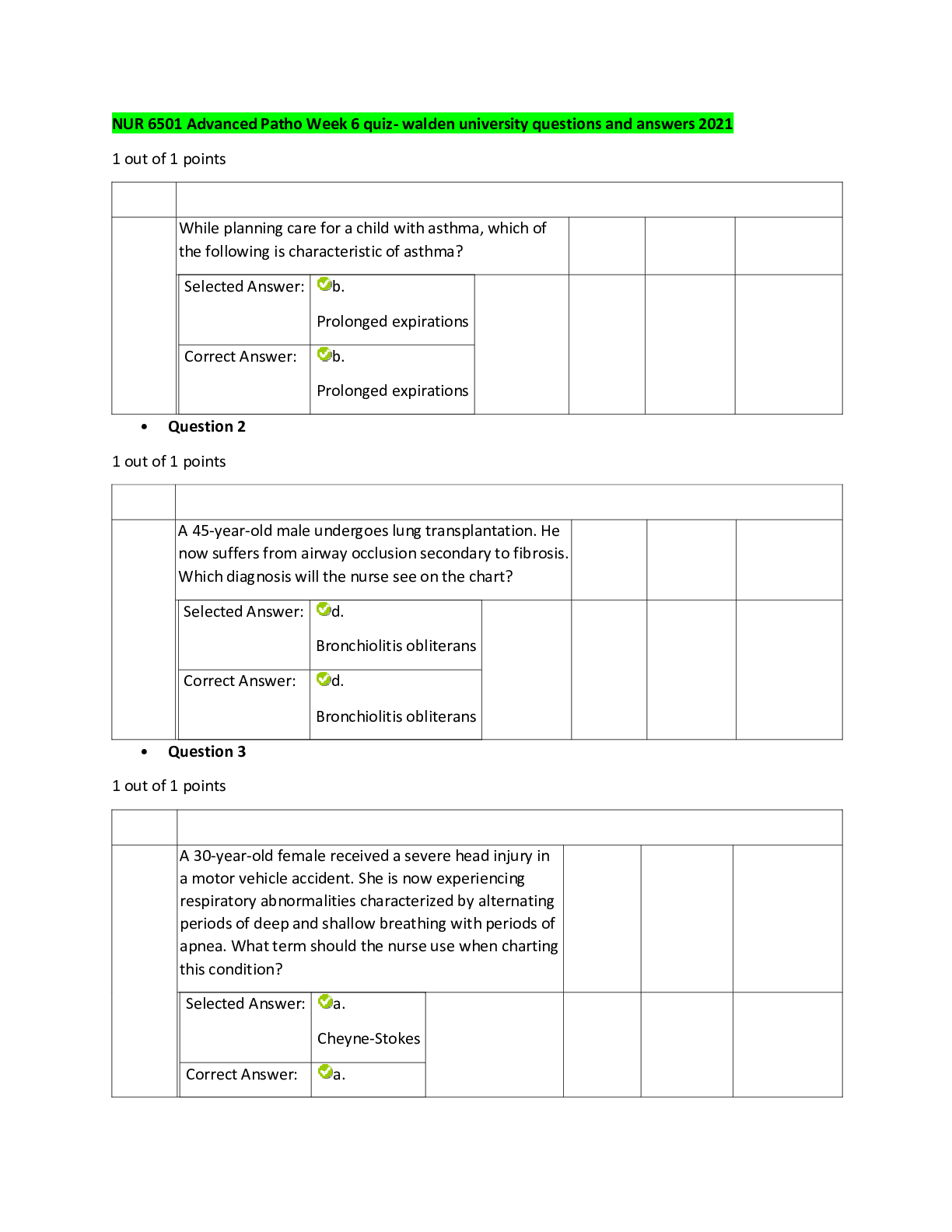



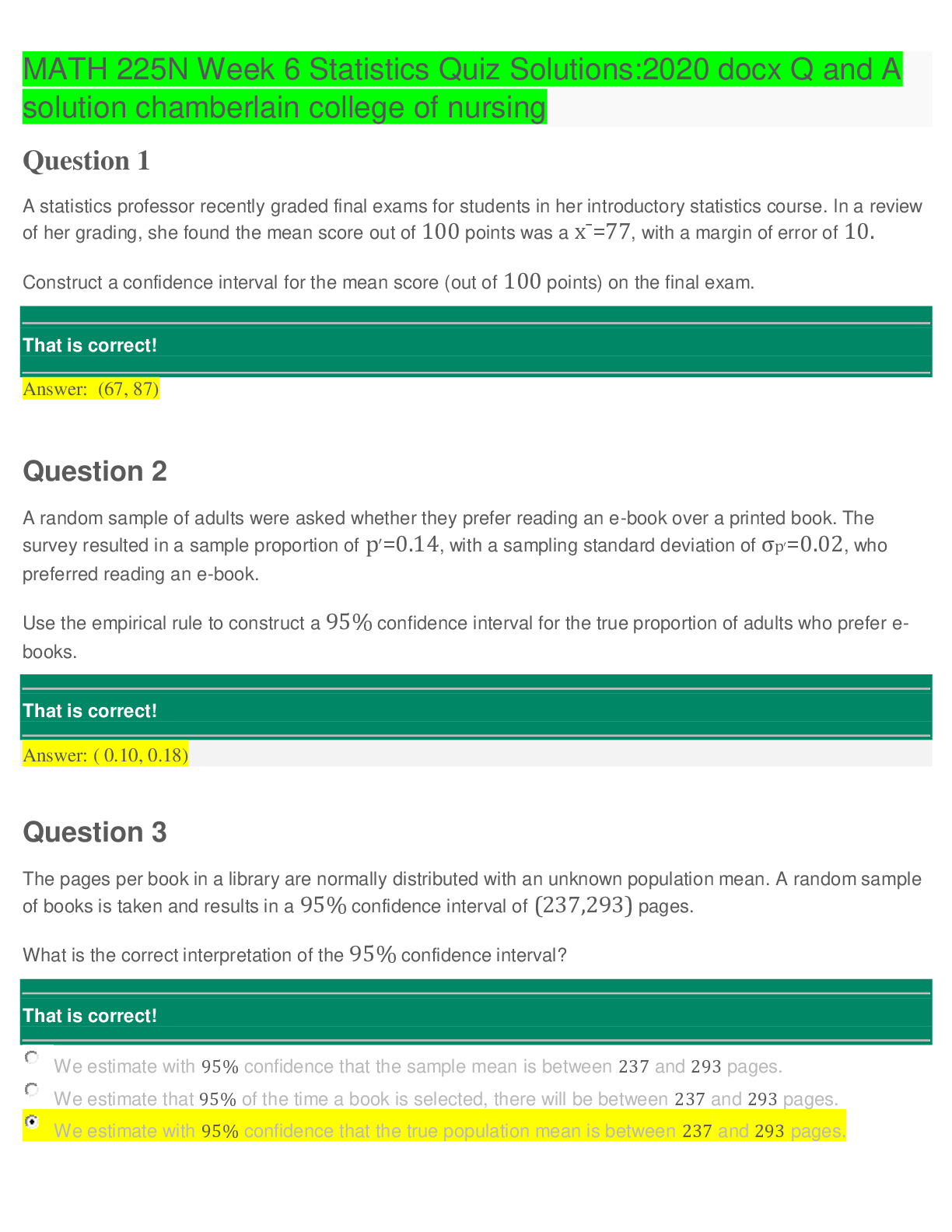

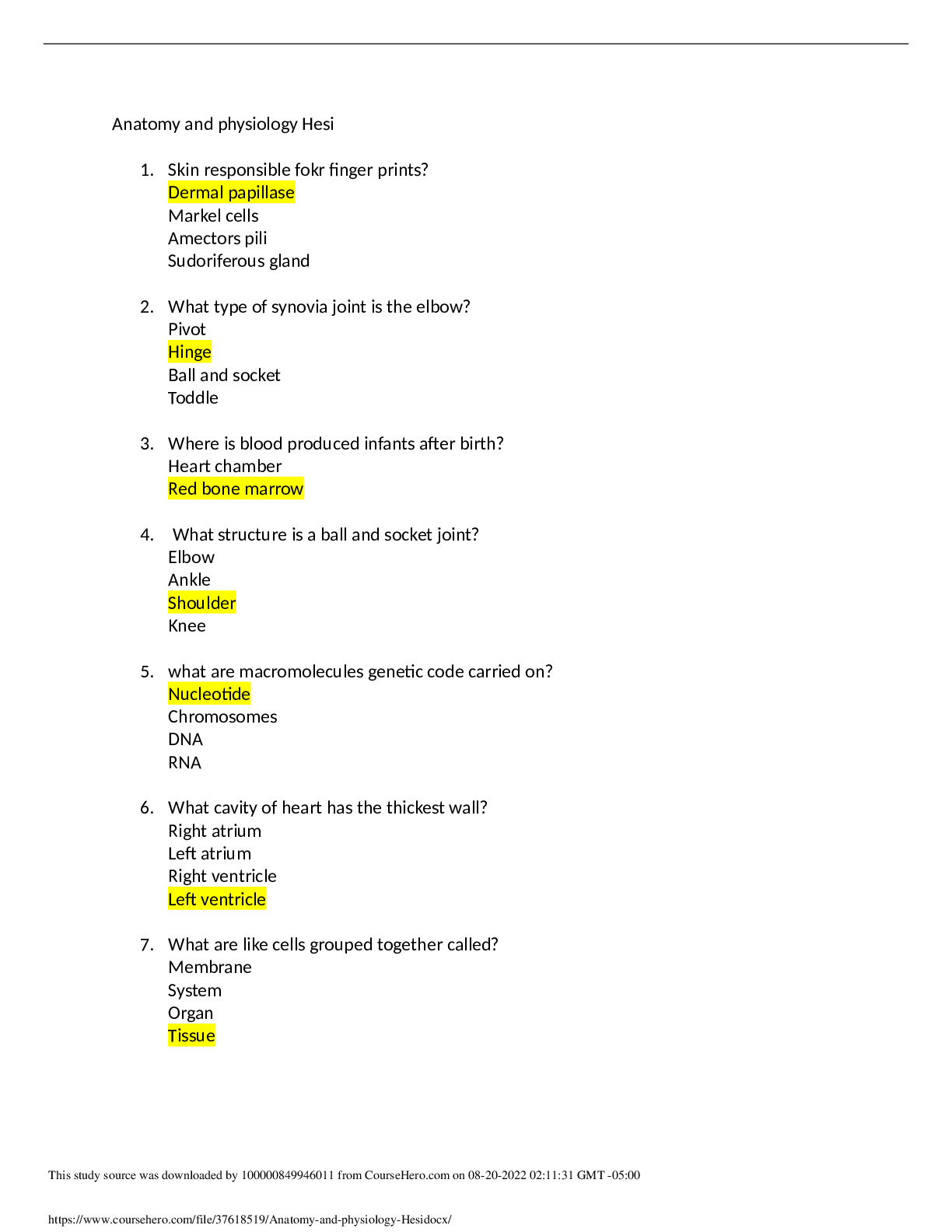
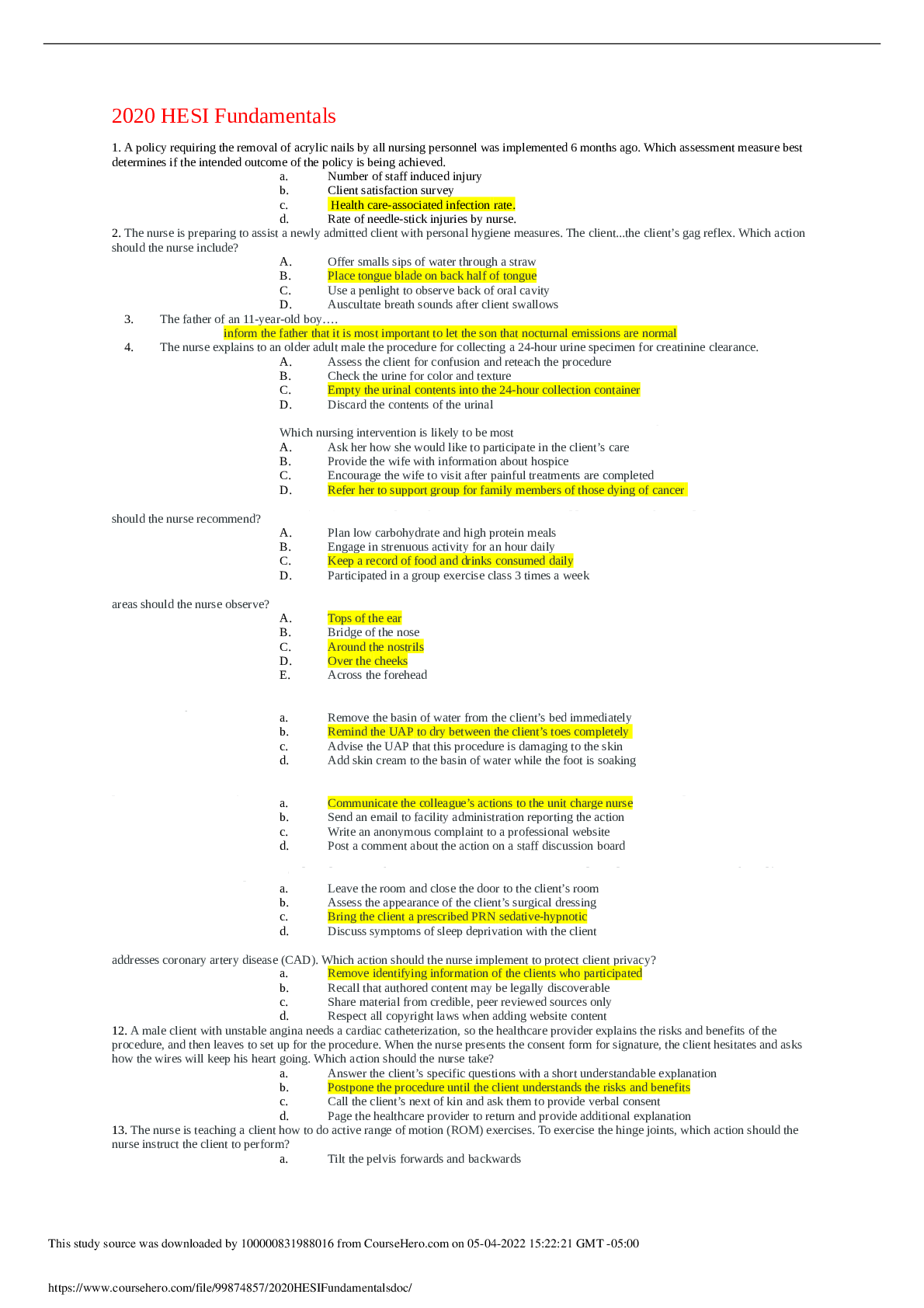

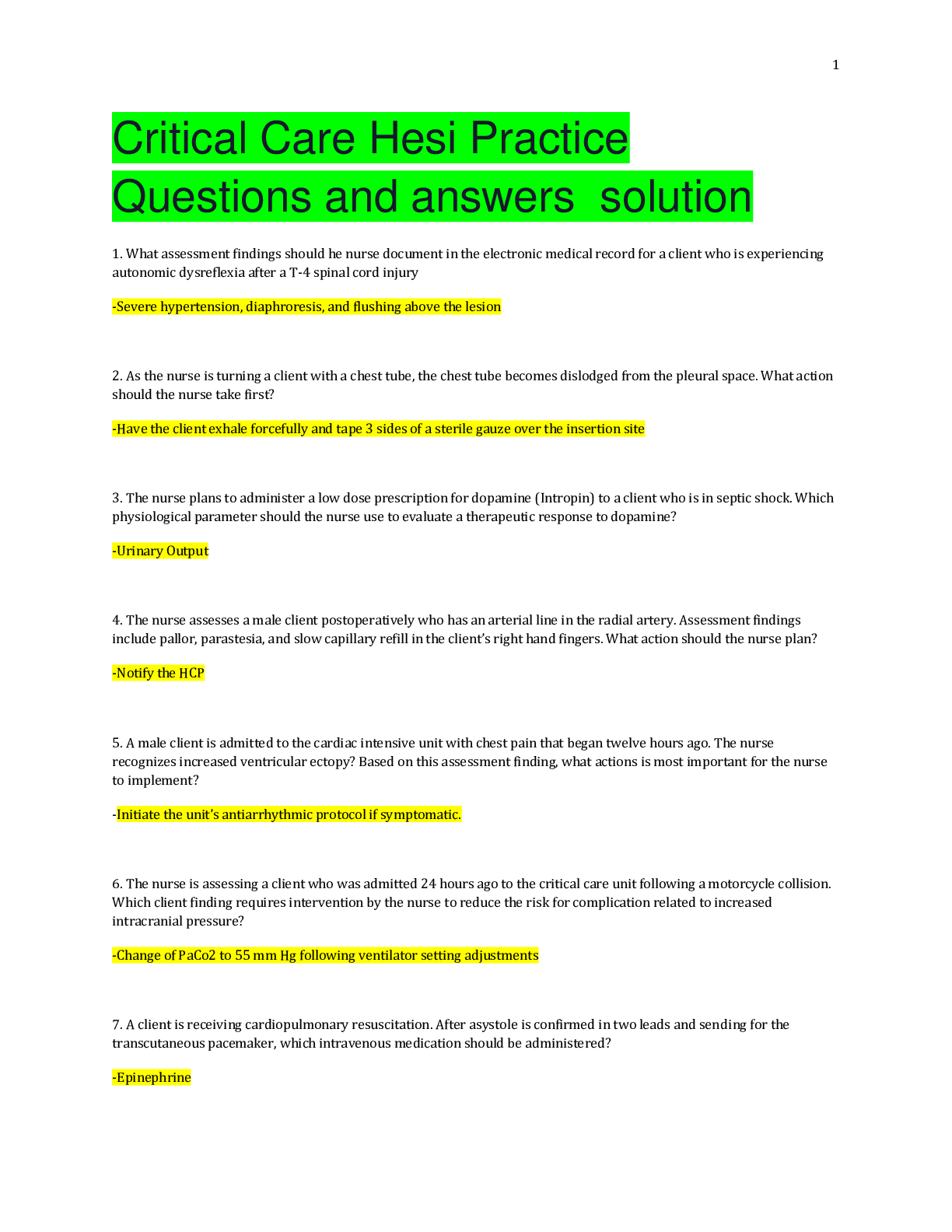
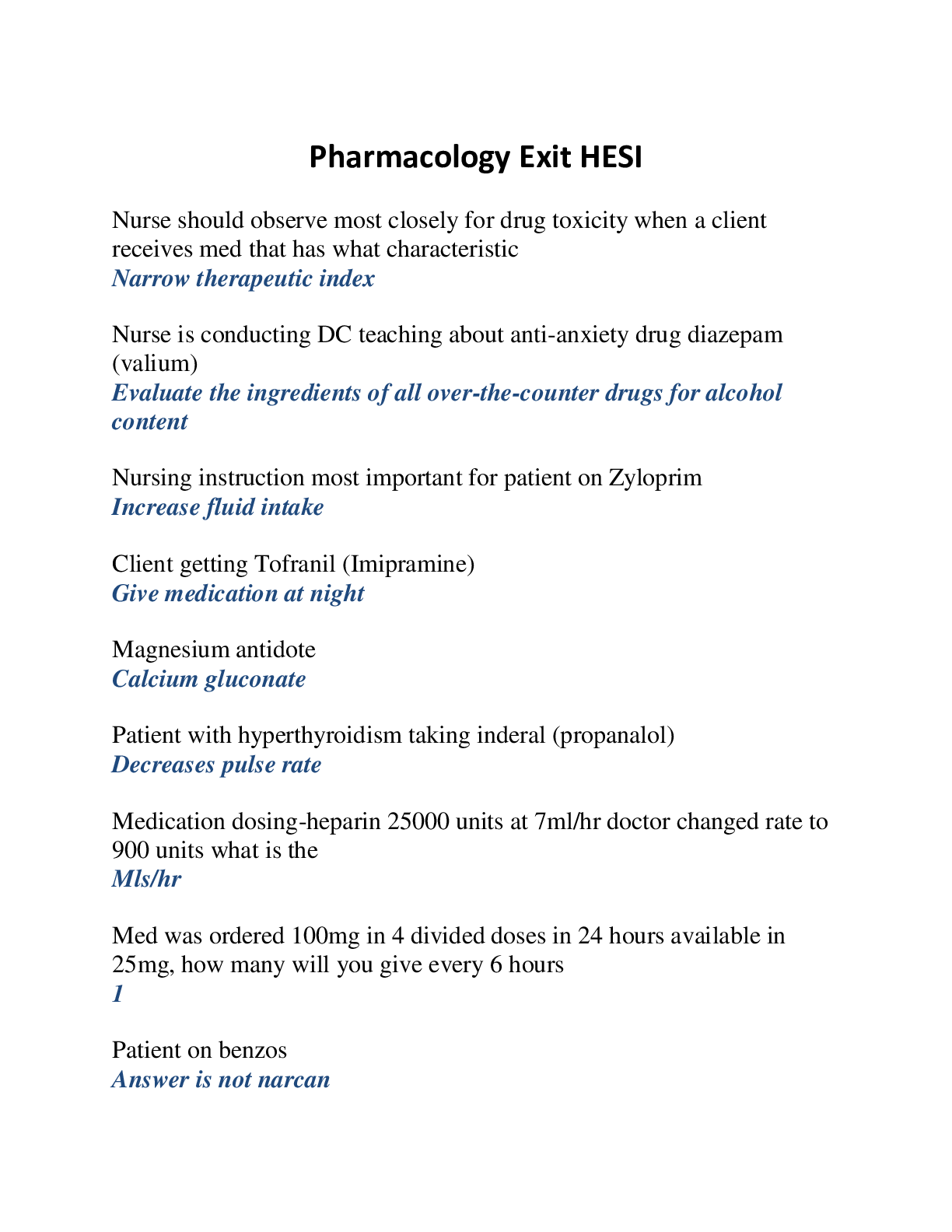
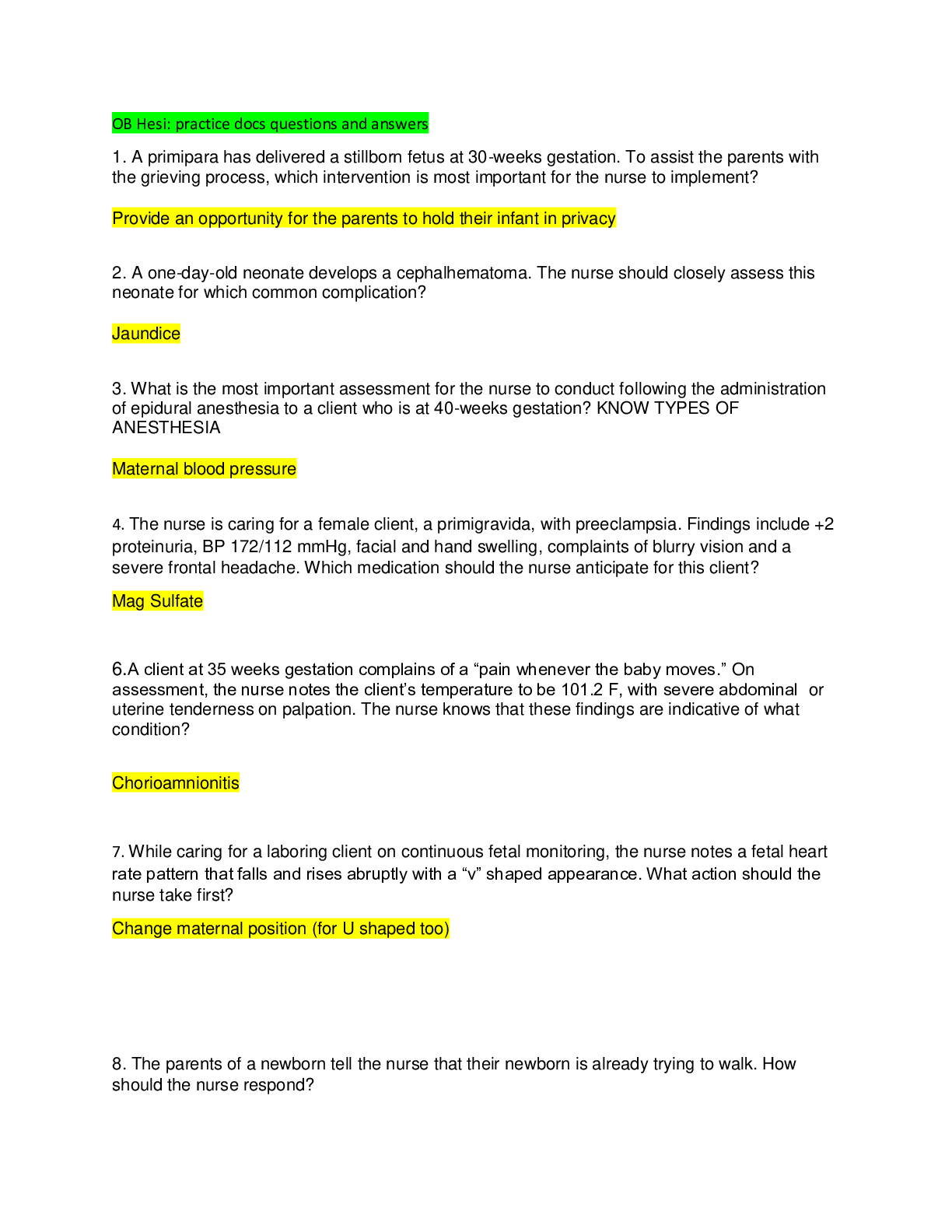
.png)

